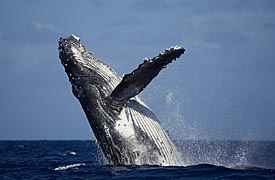 Southern-hemisphere humpback whales tend to have white or whitish bellies, which makes them easier to spot both in and above water, and arguably makes them more photogenic than their northern hemisphere counterparts, which tend to be black/ grey over most of their bodies.
Southern-hemisphere humpback whales tend to have white or whitish bellies, which makes them easier to spot both in and above water, and arguably makes them more photogenic than their northern hemisphere counterparts, which tend to be black/ grey over most of their bodies.
Over the years, I’ve grown accustomed to seeing perhaps a couple or so of predominantly black/ grey whales here in Tonga in any given season. I’ve always wondered whether these were “crossovers” from the northern hemisphere or just the result of random genetic variation.
I hadn’t really given it much more thought than that until now, except when photographing the whales.
Traditionally white-bellied whales of the southern hemisphere are, at least to me, more photogenic than their northern brethren, as the contrasting white/ dark patterns make for visually distinct and pleasing images.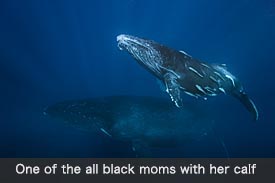
Predominantly dark whales, on the other hand, provide no visual contrast, making it difficult to distinguish the animals underwater, and also providing less variation above water.
As a result, I’m generally more enthusiastic about photographing whales with lots of white patterns, as they usually make for more visually pleasing images. That’s not to say I’d pass up the opportunity to swim with and photograph darker whales, of course!
So far this season, however, I’ve counted seven northern-like primarily dark humpbacks here — three females (all with calfs) and four males.
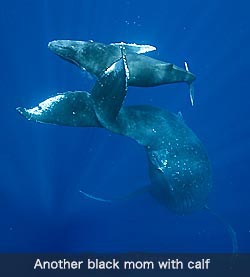 On the one hand, out of hundreds of whales here, seven isn’t an extraordinarily huge proportion. And since colours and patterns on individual whales do vary, it’s quite possible that the mostly dark individuals are just natural variations in the southern humpback population.
On the one hand, out of hundreds of whales here, seven isn’t an extraordinarily huge proportion. And since colours and patterns on individual whales do vary, it’s quite possible that the mostly dark individuals are just natural variations in the southern humpback population.
On the other hand, compared to say one or two such whales in previous seasons, seven unique sightings in three weeks or so seems to be a significant increase.
Perhaps they’ve always been here and I’m just noticing them more; or maybe it’s possible that they’ve come from other humpback populations? It’s interesting to speculate that if these were new adults from other populations, they might serve to provide variation in the genetic pool.
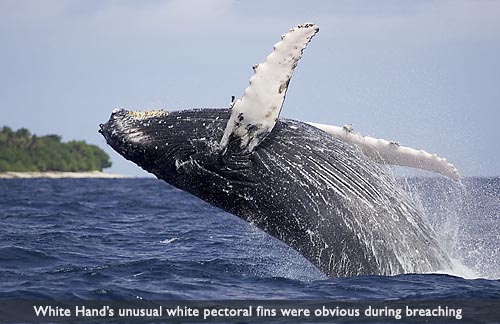
All seven of the “All Blacks”, as I’ve started to call them, are adults. The three females have calfs. Interestingly, two of the four mostly black males I’ve spotted have all white pectoral fins (top and bottom), which makes them quite easy to identify. I’ve given these two the names “White Hand” and “Scar Face”. Scar Face has lots of marks on his body, which look like scars, but again might be just natural birthmarks. The unique pectoral fins makes them very easy to identify above and below the water line.
According to one of my good friends who’s been in Tonga for fifteen years running whale-watching boats, the all-white pectoral fins are highly unusual.
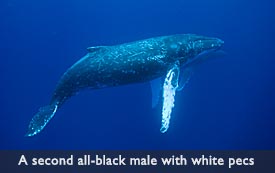 In the past fifteen years, he believes he may have seen two or three such whales in total. I have photographs of three distinct individuals this season — two males (with predominately black bodies) and a very friendly female with a calf (I’ve named this female “White Wing”).
In the past fifteen years, he believes he may have seen two or three such whales in total. I have photographs of three distinct individuals this season — two males (with predominately black bodies) and a very friendly female with a calf (I’ve named this female “White Wing”).
So — lots of all-black whales this year, and quite a number of whales with all-white pectoral fins too. What’s going on?
If anyone with more knowledge of these matters happens to read this, please drop me a line and help satisfy my curiosity!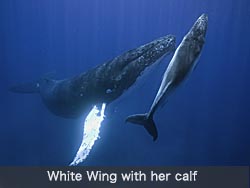
(Since preparing this post, I’ve consulted a couple of cetacean experts by email, who’ve let me know that they think the chance of crossover between northern and southern humpback populations is low, but that the chances of individual whales within the southern hemisphere visiting different wintering grounds each year is probably high.)
21 August update: Just spotted a fourth whale with all-white pectoral fins — a large male escort swimming with a mom and calf. Unfortunately, the visibility underwater wasn't good enough to get a usable photo, but I was able to get surface photos of the dorsal fin to compare to the other two males with all-white pecs for a positive ID.
[tags]Humpback Whale, Cetacean, Tonga[/tags]